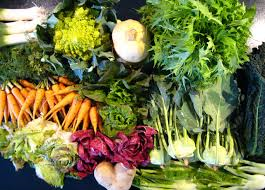
Although each of these claims may be true, for me the answer is simpler: I grow food for my table. As I have become a more knowledgeable vegetable gardener, I have wanted to increase the variety of crops I grow and to harvest year round.
Plants are adapted to grow at specific temperatures. Some annual vegetables prefer warm weather; others perform best when it’s cool. Warm-season plants grow best in daytime temperatures of 65°F to 95°F. They thrive when night-time temperatures stay above 50°F. Most of them tolerate high temperatures but are damaged or killed by frost. Cool-season crops prefer cooler soil and air (55°F to 75°F), perform poorly when temperatures are high, and tolerate or are improved by frost.
When researching average temperatures for Napa County, I found some useful graphs on the Weather Channel’s website (www.weather.com). From May to October, our average lows range from 49°F to 55°F, while average highs for the same months are 76°F to 83°F. The months of November to April see average lows of 39°F to 45°F degrees, and highs of 57°F to 71°F. If our weather is not too extreme, we can accommodate cool-season vegetables six months a year and warm-season vegetables during the other half.
So growing vegetables year-round in Napa County is just a matter of timing: growing the right plants at the right time.
Year-round vegetable gardening uses soil intensively, so maintaining fertility is critical.
Soil is comprised of four principal components: minerals, organic matter, air and water. Minerals and organic matter make up about half of the volume of typical California soils, with minerals being by far the largest part. Soil minerals are basically decomposed rock. The size of the particles determines whether your soil is sandy (large particles), loam or clay (small particles).
Organic matter consists of decomposing plant and animal residue, living soil organisms (earthworms, fungi, bacteria) and the substances they synthesize.
The other half of the soil’s volume is the pore spaces between the solid particles. In soils with ideal moisture content, the pore spaces are about half water and half air. Typical soil by volume will be about 45 percent minerals, 25 percent water, 25 percent air and 5 percent organic matter.
Soils can be coarse and sandy or fine and clay-like. Their texture reflects the mineral content, which is difficult to alter. However, increasing the organic matter in sandy or clay soils changes the way the soil aggregates, or clumps, and improves the conditions for growing plants.
Although the living organisms in soil comprise a small percentage of its volume, mounting scientific evidence suggests that these organisms play a significant role in helping plants fight disease and pests. Many soil microorganisms live in beneficial relationships with roots. These organisms digest organic matter over time and need air and moisture to survive. Even when you don’t have a crop in the ground, you need to provide an environment that encourages this soil life. In a year-round vegetable patch, you should add compost or other organic amendments at least twice a year, or each time a new crop is planted.
Our California soils tend to be low in nitrogen, a major nutrient for growing plants. Your soil may also be lacking in other nutrients. Year-round vegetable gardening can quickly deplete soil nutrients. If your organic amendments are not relatively high in nutrients, you will need to fertilize several times a year. Although you can use synthetic fertilizers, they can harm the natural soil life. Use all fertilizers carefully, following package directions and never using more than recommended.
Plants interact with soil in different ways. Just as farmers do, home gardeners should rotate crops to prevent soil-borne diseases from getting established and to foil pests that prefer specific crops.
So here’s 12-month gardening in a nutshell: plant the right plants for the season;feed the soil with organic amendments; use fertilizers as needed; and rotate plants. Then proceed to enjoy homegrown food year round.
Workshop: Napa County Master Gardeners will conduct a workshop on “Success with Veggies All Year Long” on Saturday, January 25, from 9:30 a.m. to 11:30 a.m., at the University of California Cooperative Extension, 1710 Soscol Avenue, Napa. Learn how to keep your garden soil healthy and productive, find out which vegetables to plant in what months, and be introduced to many reliable resources. Online registration (credit card only)Mail in registration (cash or check only)
Napa County Master Gardeners welcome the public to visit their demonstration garden at Connolly Ranch on Thursdays, from 11:00 a.m. until 1 p.m., except the last Thursday of the month. Connolly Ranch is at 3141 Browns Valley Road at Thompson Avenue in Napa. Enter on Thompson Avenue.
Master Gardeners are volunteers who help the University of California reach the gardening public with home gardening information. Napa County Master Gardeners ( http://ucanr.org/ucmgnapa/) are available to answer gardening questions in person or by phone, Monday, Wednesday and Friday, 9 a.m. to Noon, at the U. C. Cooperative Extension office, 1710 Soscol Avenue, Suite 4, Napa, 707-253-4143, or from outside City of Napa toll-free at 877-279-3065. Or e-mail your garden questions by following the guidelines on our web site. Click on Napa, then on Have Garden Questions? Find us on Facebook under UC Master Gardeners of Napa County.